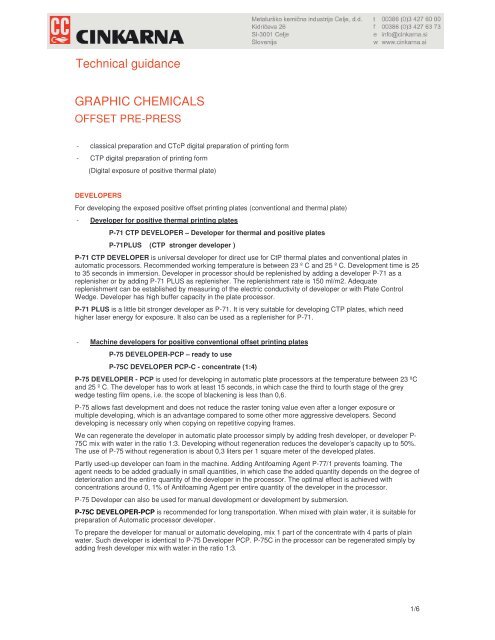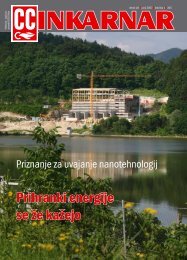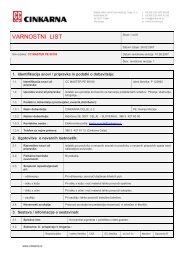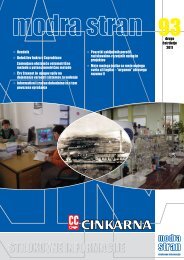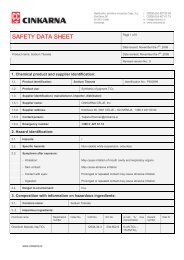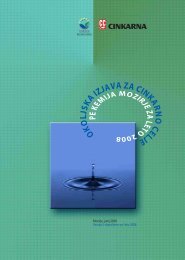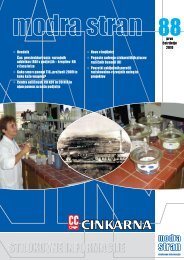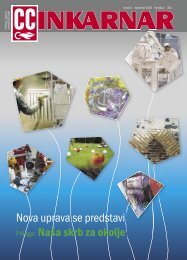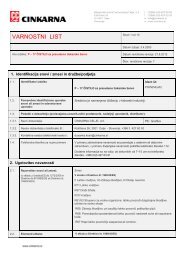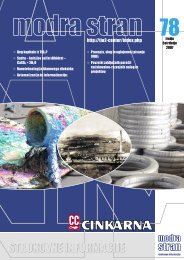Technical guidance GRAPHIC CHEMICALS
Technical guidance GRAPHIC CHEMICALS
Technical guidance GRAPHIC CHEMICALS
Create successful ePaper yourself
Turn your PDF publications into a flip-book with our unique Google optimized e-Paper software.
<strong>Technical</strong> <strong>guidance</strong><strong>GRAPHIC</strong> <strong>CHEMICALS</strong>OFFSET PRE-PRESS- classical preparation and CTcP digital preparation of printing form- CTP digital preparation of printing form(Digital exposure of positive thermal plate)DEVELOPERSFor developing the exposed positive offset printing plates (conventional and thermal plate)- Developer for positive thermal printing platesP-71 CTP DEVELOPER – Developer for thermal and positive platesP-71PLUS (CTP stronger developer )P-71 CTP DEVELOPER is universal developer for direct use for CtP thermal plates and conventional plates inautomatic processors. Recommended working temperature is between 23 º C and 25 º C. Development time is 25to 35 seconds in immersion. Developer in processor should be replenished by adding a developer P-71 as areplenisher or by adding P-71 PLUS as replenisher. The replenishment rate is 150 ml/m2. Adequatereplenishment can be established by measuring of the electric conductivity of developer or with Plate ControlWedge. Developer has high buffer capacity in the plate processor.P-71 PLUS is a little bit stronger developer as P-71. It is very suitable for developing CTP plates, which needhigher laser energy for exposure. It also can be used as a replenisher for P-71.- Machine developers for positive conventional offset printing platesP-75 DEVELOPER-PCP – ready to useP-75C DEVELOPER PCP-C - concentrate (1:4)P-75 DEVELOPER - PCP is used for developing in automatic plate processors at the temperature between 23 ºCand 25 º C. The developer has to work at least 15 seconds, in which case the third to fourth stage of the greywedge testing film opens, i.e. the scope of blackening is less than 0,6.P-75 allows fast development and does not reduce the raster toning value even after a longer exposure ormultiple developing, which is an advantage compared to some other more aggressive developers. Seconddeveloping is necessary only when copying on repetitive copying frames.We can regenerate the developer in automatic plate processor simply by adding fresh developer, or developer P-75C mix with water in the ratio 1:3. Developing without regeneration reduces the developer’s capacity up to 50%.The use of P-75 without regeneration is about 0,3 liters per 1 square meter of the developed plates.Partly used-up developer can foam in the machine. Adding Antifoaming Agent P-77/1 prevents foaming. Theagent needs to be added gradually in small quantities, in which case the added quantity depends on the degree ofdeterioration and the entire quantity of the developer in the processor. The optimal effect is achieved withconcentrations around 0, 1% of Antifoaming Agent per entire quantity of the developer in the processor.P-75 Developer can also be used for manual development or development by submersion.P-75C DEVELOPER-PCP is recommended for long transportation. When mixed with plain water, it is suitable forpreparation of Automatic processor developer.To prepare the developer for manual or automatic developing, mix 1 part of the concentrate with 4 parts of plainwater. Such developer is identical to P-75 Developer PCP. P-75C in the processor can be regenerated simply byadding fresh developer mix with water in the ratio 1:3.1/6
<strong>Technical</strong> <strong>guidance</strong>- Manual developers for positive conventional offset printing plates:P-76 DEVELOPER-R - ready to useP-76C DEVELOPER-RC – concentrate (1:9)They serve as preparation for printing forms on the positive working offset plates, and can be used for the majorityof positive working plates. The exposure and developing time are determined by the grey scale copy of the testingfilm. We recommend extending the exposure time rather than the developing time.After the developing is done, both sides of the plate have to be washed with water. The remainder of alkalinedeveloper on the surface of the printing elements may cause plate blinding during the print or blank surfacestoning.To avoid such problems, we recommend using anti-toning, gumming and preserving chemicals.P-76 – DEVELOPER-R is used for manual developing of offset plates with a cotton tampon. The developing timeis 1 to 1, 5 minutes with twice added developer. The developer is removed from the plate with a rubber wiper.The expected use is up to 0,8 L of P-76 per 1 square meters of the developed plate.P-76C – DEVELOPER-RC is a 10-time concentrate suitable for long transportation. The developer is prepared byadding 1 liter of concentrate to 9 liters of water. To avoid problems caused by decomposition of the concentrate,the whole quantity (1 L) of the concentrate has to be diluted at once.At high working temperatures we recommend diluting concentrate in the ratio 1:10; at low temperatures therecommended dosage/ratio is 1:8.GUMMING AND PRESERVING <strong>CHEMICALS</strong>They are used for the protection, gumming and archiving of offset printing formsP-12 OFFSETGUM – Gumming Solution (neutral)P-47 OFFSETGUM-UNI – universal gumming solutionP-81 THERMOGUM For baking and gumming – solution for thermal treatment and gummingP-20 G-CLEANER – washing and gumming solutionThey are water solutions of gum Arabic or its substitutes with certain additives. The solutions are applied thinlyand evenly to the damp plate surface. The gumming coating film is washed off the plate with water and spongejust before we start printing, or it can be removed with fountain solution when starting with printing.P-12 OFFSETGUM is a neutral chemical used for gumming offset printing forms.P-47 OFFSETGUM-UNI is a neutral gum solution for plate developer processors and manual use. It is used forgumming and preserving in developer unit as last phase before drying. P-47 can be left on printing plate for longertime. P-47 can be used also for manual gumming and archiving the plates instead of P-12. It is easy to removewith water without residues. Wipe the plate with water and sponge before printing, or it can be removed withfountain solution during the first few imprints.P-81 THERMOGUM is used to protect oleophylised areas (printing elements) on the printing plate during thermaltreatment (baking). This process is necessary to increase the plate printing endurance. This chemical is usuallyused in automatic processors where at least a portion of plates is thermally treated. This chemical can be alsoused instead of gumming agent.Short-term protection: leave the printing images covered with printing ink and gum up the entire plate thinly andevenly with P-12 or P-47.Before rerunning, wash off the protective layer (gumming medium) with a wet sponge and water. Dried printinginks remove with cleaners P-23, P-24, ACTIVATOR P-211 or P-212 CTP CLEANER. Wet the plate with water andproceed with printing.For archive:Remove the printing ink from the wetted plate using P-23, P-24 or P-211 and rinse well with water. Pour P-72Antiton P over the whole surface to hydrophylise blank areas, rinse it with water, gum it thinly and evenly with P-12 or P-47 and dry.2/6
<strong>Technical</strong> <strong>guidance</strong>P-20 G-CLEANER is used for washing and gumming the printing plate in one step in printing machines betweenshorter and longer breaks. Clean the printing plates with P-20G leave it on plate to dry and plate is protected. P-20G is removed and washed from the plate with a wet sponge just before we start printing.Caution! Shake the dose with P-20G before use.CORRECTING MEDIUMSCorrecting mediums are used for removing redundant printing elements from offset printing plate (printing form)P-73 CORRECTOR – Corrector gelP-73/1 CORRECTOR – Corrector pencilCorrecting mediums are used for removing redundant printing elements, such as copies of film edges orunwanted bits, from offset plates. They are suitable for certain types of Kemolit® PCP Printing Plates but also forother positive offset plates.It is used for correcting positive working offset plates coated with diazo-type coating. It comes in a form of gel (P-73) or as corrective pencil (P-73/1). Gel is applied to the plate with a brush. After one minute, rinse the plate withwater or wipe the corrected spot with a sponge.When applying and washing, be careful. Not to spread the correcting medium to other parts of the plate. Sinceboth mediums dry up fast, replace the cap immediately after use.SPECIAL CLEANERSUsed for cleaning ink without damaging the printing formP-211 ACTIVATOR – plate cleaner for conventional platesP-212 CTP CLEANER – plate cleaner for thermal platesP-211 ACTIVATOR is very intensive cleaner. Removes printing ink, dried ink and cleans the plate mechanically(oxidation marks) Recommended for standard offset plates.Plates are cleaned in a sink, on a flat surface or on the printing machine. The agent is poured over the plate andevenly dispensed with a sponge across the entire surface. If necessary, the plate can be rubbed gently with asponge dipped in P-211. The plate is then rinsed with running water, or cleaned with a wet sponge. The cleanedplate can now be gummed and put back into the press, or archived.P-212 CTP CLEANER is used for cleaning CTP plates. It cleans ink very well and does not damage printing form.It is free from any abrasive substances. CTP cleaner is applied to the plate with soft sponge. The CTP cleanermay also be used for cleaning of conventional plates.DEPOSITS REMOVERSolution for removing various insoluble deposits in developing units.P-60 REMOVER – calcium deposits removerP-60G REMOVER GEL – calcium deposits remover - gelP-60 REMOVER is effective cleaner for removing insoluble calcium and magnesium salts from blankets androllers. Drain the developer from the developing unit of the processor, remove the filters and rinse themthoroughly with water. Fill the processor with the cleaner and warm it up to the working temperature or higher.Higher temperature boosts the cleaner, which results in better efficiency. Depending on the thickness of theresidue, let the cleaner work up to half an hour, with periodic circulation of the pump.The developing unit of the processor, including the transport system is now clean. Transport rollers and filtersshould be soaked in cleaner for some time and the residue is cleaned by brushing it with an abrasive sponge.Finally, rinse the processor and the developer’s transport system thoroughly with water and fill it with freshdeveloper.3/6
<strong>Technical</strong> <strong>guidance</strong>Caution! The remaining Cleaner may neutralize fresh developer.P-60G REMOVER GEL is a gel used for the same purpose as the liquid P-60. Its advantage is reducedconsumption, since it is applied only on the rollers and walls of the developing machine. Gel is left for certain timeto work, and then washed off thoroughly with water.OTHER <strong>CHEMICALS</strong>P-72 ANTITON-P – For neutralization of developer remains from the plate and to prevent toningP-77/1 ANTI FOAMING AGENT – developer adding agent to avoid foaming duringmachine developingP-72 ANTITON-P is used to neutralize the remaining alkaline developer after the developing is done. It also actspreventively towards the occurrence of toning during printing.Instruction for use: Pour P-72 over the plate, let it work for half or one minute and rinse the plate well with water.Too long action may cause plate blinding.P-77/1 ANTI FOAMING AGENT is added to the developer in automatic plate processor. It reduces foam formingof partly used developer during pumping. Add P-77/1 to the developer several times in small doses. The dosagedepends on the amount of used-up developer.P-77/1 ANTI FOAMING AGENT also serves as a universal additive to prevent foaming of fountain solution andcleaning solution foaming.The perfect effect is achieved by adding small quantities of P-77/1 (up to 0.1%).<strong>GRAPHIC</strong> <strong>CHEMICALS</strong>OFFSET PRESS<strong>CHEMICALS</strong> FOR FOUNTAIN SOLUTIONSThe structure of fountain solution effects on quality of print. These chemicals reduce surface tension and allowprinting with reduced water quantity. Chemicals used for preparation of fountain solution contain agents whichmaintain stable pH value.P-43 Prepared Isopropyl Alcohol – prepared isopropyl alcohol 99,9%P-41 SUPER BUFFER – classic bufferP-50 UNI BUFFER – buffer for printing without alcoholP-51 UNI PLUS BUFFER – concentrate bufferP-55 EKO BUFFER – buffer for printing with reduced quantity of alcoholP-55R EKO BUFFER-R – buffer for web offset printing with less alcoholP-56 ALCOHOL BUFFER – buffer for using alcohol fountain solutionChemicals contain ingredients which prevent algae and fungi growing in the fountain solution and dampeningsystems and do not cause corrosion.P-43 Prepared Isopropyl Alcohol is used in presses with alcohol dampening. Around 20% of P-43 can beadded, depending on the printing conditions.P-41 SUPER BUFFER is used for all types of offset plates. It is based on isopropyl alcohol and has to be dilutedwith water (1 l of P-41 per 10 l of water). The pH value of fountain solution is between 5 and 5.5. Applying such4/6
<strong>Technical</strong> <strong>guidance</strong>solution provides a constant balance between water and ink in a wide range, proper harmony and better imprintcontrast.Adding P-50 UNI BUFFER depends upon the desired pH and initial hardness of water. Depending on the systemof dampening, our recommendation is to add from 1 to 3%, thus reaching the dampening water pH from 4.7 to5.5. Start with lower additive, and gradually increase till you reach optimum print quality.If requirement and printing conditions entail adding isopropyl alcohol (IPA), its concentration must be predeterminedwith a test. Initial quantity must be not less than 3% of P-43 Prepared isopropyl alcohol.Buffer ingredients prevent formation of algae, corrosion of printing machine components and buildup of lime.P-51 UNI PLUS BUFFER Concentrate for sheet fed and web offset printing. Add P-51 into water 2 – 3% and upto 10% of isopropyl alcohol. It is used for conventional and UV inks. P-51 prevents formation of calcium depositsand algae in dampening system as well as corrosion of dampening system.P-55 EKO BUFFER is buffer for printing with reduced quantity of alcohol. It is buffer for sheet fed and web offsetprinting. P-55 stabilizes pH value of damping solution, buffer ingredients prevent formation of algae, preventcorrosion of printing machine components and buildup of lime.Our recommendation is to add from 2 to 4 % of P-55. The quantity depends on the quality of water. Therecommendable dosage of P-43 Prepared Isopropyl Alcohol is from 8 to 10 %.The influence of water hardnes on the pH value offountain solution5,6pH value of fountain solution5,55,45,35,25,154,9P-55 2% by volumeP-55 3% by volumeP-55 4%by volume4,87 14 21water hardness °dHTable: pH Value and electrical conductivity of the solution depending on the water qualityTap waterConductivity 744µS/cmHardness 21 o dHTap waterConductivity 449µS/cmHardness 14 o dHP-43IPA 44Conc. P-55 66without 10% without 10%pH Conductivity pH Conductivity pH Conductivity pH Conductivity2% 5,48 1063 5,62 755 5,22 992 5,33 7093% 5,26 1474 5,37 1056 5,06 1391 5,16 10034% 5,14 1831 5,25 1311 5,00 1737 5,08 12685/6
<strong>Technical</strong> <strong>guidance</strong>Deionised water + P-58Conductivity 260µS/cmHardness 7 o dHTap waterConductivity 260µS/cmHardness 7 o dHP-43IPA 44Conc. P-55 66without 10% without 10%pH Conductivity pH Conductivity pH Conductivity pH Conductivity2% 4,90 973 4,97 698 5,10 923 5,20 6803% 4,89 1358 4,95 983 4,96 1354 5,08 9784% 4,87 1719 4,94 1258 4,92 1588 5,02 1202P-55R EKO BUFFER-R For sheet fed and web offset printingIt is a universal additive used for fountain preparation. It can be used in web (P-55R) and sheet (P-55) offsetprinting. To prepare the solution, around 1 to 3% of P-55 is added, depending on a suitable pH and waterhardness.In alcohol dampening printing presses it reduces demand for alcohol by more than 50%.Compared to other traditional buffers it is safe for people because it contains low percentage of vaporized organicelements, it is environmentally friendly, safe and biodegradable.It is also anti-corrosive thus preventing the corrosion of plates and metal cylinders in the printing press. It alsocontains the inhibitor which prevents algae and fungi growing in the dampening system.P-56 ALCOHOL BUFFER is used in alcohol dampening printing presses for all types of offset plates. It is appliedtogether with P-43 Prepared Isopropyl Alcohol. Usually dosing is performed automatically, at the beginningsolution is prepared manually. Taking into consideration the water hardness 10 to 20% of P-43 and 2 to 3% of P-56 is added to water.ANTITONING <strong>CHEMICALS</strong>They are used for additional hydrophylization of non-printing elements on the offset printing plates and to preventtoning during printing.P-15 PLATE ETC – for preventing and elimination of toning during printingP-72 ANTITON-P – for neutralization of developer remains from the plate andto prevent toningP-15 PLATE ETCH is used for preventing plate toning in the machine.P-15 can be diluted with water in the ratio 1:1. During application, the printing elements have to be coated withprinting ink otherwise plate blinding can occur.Instruction for use: Coat the plate in the machine with a thin layer of the P-15, rinse with water after a minute andproceed with printing.P-72 ANTITON-P is used to neutralize the remaining alkaline developer after the developing is done. It also actspreventively towards the occurrence of toning during printing.Instruction for use: Pour P-72 over the plate, let it work for half or one minute and rinse the plate well with water.Too long action may cause plate blinding.CLEANERS6/6
<strong>Technical</strong> <strong>guidance</strong>When using cleaners, special attention has to be paid to rubber rollers and offset blankets of the printing press.Cleaning with improper agents can cause changes in their flexibility and on their surface. Special gloss caused bycertain chemicals, like solutions for gumming, wetting and ink residues may cause weaker distribution andtransfer, or even rubber cracking.In addition to regular everyday cleaning, a thorough deep cleaning of rollers has to be done occasionally to openthe pores and to remove the remaining ink. This makes the surface smooth and flexible again, providing highquality print.Regular cleaning can prolong the life of rollers and rubbers. Stoppages during printing caused due to the changeof the printing ink, especially when changing from dark to light tones, are much shorter, which also reduces thecost of printing and improves the quality.P-21 WASH - for ink rollers and blanketsP-23 WASH AII – for ink rollers and blankets and printing platesP-24 WASH AIII – for ink rollers and blankets and printing platesP-25 UV CLEANER-UV – ink cleanerP-26 ULTRA WASH AIII – universal cleaner for UV, hybrid and conventional inksP-202 WASH-VV – dampening rollers washP-21 WASH is universal cleaner for cleaning ink rollers and rubber gums. Pour P-21 over the ink rollers. When inksoftens, set the wiper to remove it while the rollers are rotating. Repeat the procedure until the rollers are totallyclean.When cleaning rubber blankets, apply the solution with a soft cloth across the entire surface and wipe it off with aclean cloth after some time. P-21 is also suitable for automatic processor cleaning of rubber blankets.P-23 WASH AII is highly effective with great capability of dissolving ink. Cleaner can be mixed with water or it canbe used by itself. When mixed with water the stable solution is formed, which quickly removes ink gum glaze,paper fibers and other impurities – we recommend 30% of water. P-23 is very economical, fast drying cleaner; ithas a flash point above 43 ° C (AII group). P-23 contains corrosive inhibitors, which prevents the corrosion ofmetal parts of the printing presses.P-24 WASH AIII is cleaner with high power of cleaning. It is suitable for automatic washing systems and formanual cleaning. It is the answer for demands of all modern printing machines. P-24 has lower point ofinflammability. It belong to AIII group (flash point above 58° C), therefore it gives safer working conditions anddoes not have any special strict demands for storage and transport.P-24 does not have unpleasant odor. It can be used as itself or it can be mixed with water (recommended 30% ofwater). Mixing with water it forms white stable emulsion, which has very effective cleaning properties: it cleansrubbers, plates and rollers. At the same time it cleans ink, paper fibers and other impurities. P-24 containscorrosive inhibitors, which prevents the corrosion of metal parts of the printing presses.Cleaning the printing platesP-23 or P-24 pour on the soft sponge and wash the plate. After that rinse the plate with water and dry it with wetclean sponge. P-23 and P-24 do not grease and do not injure the printing elements. For cleaning the plates theemulsion can be used, which is made by adding 30% of water to P-23 or P-24.Cleaning the ink rollersFor cleaning ink rollers we recommend using P-23 or P-24 without adding any water. The cleaning should bedone on ink rollers while running. Pour P-23 or P-24 on the ink rollers. When ink softens, set the wiper to removeit while the rollers are rotating. Repeat the procedure (if needed) until the rollers are totally clean. At the end therollers sprinkle with water in order to eliminate paper fibers, and then dry the rollers. For best results werecommend adding up to 20% of water into cleaner.Cleaning the dampening rollers7/6
<strong>Technical</strong> <strong>guidance</strong>In case of dampening rollers with coating we recommend using undiluted cleaners P-23 or P-24. Manual cleaningof dampening rollers should be done in a suitable sink, pour the cleaner over the rollers, then brush the rollersand after that rinse with water.P-23 and P-24 can also be used for automatic cleaning system on classic dampening rollers. In case of moderndampening systems cleaning is performed in the printing machine together with ink rollers.Manual cleaning is performed by wiping the rollers with the cloth or sponge soaked with cleaner. At the end of thecleaning wipe the rollers with clean wetted cloth. For cleaning rubber dampening rollers cleaning emulsion can beused (adding up to 20% of water).Cleaning the gum rubberPour P-23 or P-24 on the cloth or sponge and apply on rubber, afterwards remove the cleaner with wetted cleancloth. We recommend using the emulsion made with up to 30% of water, therefore we avoid preliminary cleaningwith water. After the cleaning the rubber should not be sticky.P-25 UV CLEANER is environmentally and user friendly cleaner of UV-inks. It is the universal cleaner for cleaningink rollers and damping rollers, printing rubber and plates in the UV-ink printing process.Due to its ability of mixing with water, the cleaner is suitable both for automatic and manual cleaning.In case of manual cleaning, pour the cleaner over ink rollers during their rotation, leave the ink to dissolve, set thewiper and remove the cleaner along with dissolved ink. Finally rinse the rollers with water to remove paper dust,and to speed up the drying process on roller surface.Ink from the surface of a plate is removed with a sponge, soaked in cleaner. Finally wipe the plate with clean wetsponge. The cleaner is suitable only for baked plates, because it will dissolve any non-baked printing elements.Printing rubber is cleaned by the same procedure.Traditional humidifiers are cleaned by pouring the cleaner over them, brushing thoroughly and rinsing well withwater. Rubber humidifier rollers are first wiped with the cleaner, and then with clean water.P-26 ULTRA WASH AIII is new universal cleaner with great power of cleaning. It is suitable for removing the UV,hybrid and conventional inks off the ink rollers and rubber gums. Cleaner is suitable for different kinds of systemsfor automatic cleaning. P-26 can be used undiluted or it can be diluted with water up to 30%. P-26 has lower pointof inflammability, flash point is above 55° C (AIII group), has mild odour, therefore gives better working conditionand is environmentally friendly.Automatic cleaningPour the undiluted cleaner P-26 in one reservoir. In the second reservoir is water. Alternate the water and thecleaner are sprinkling on the rollers, and than all together with dissolved ink and other impurities is draining off therollers.Manual cleaningWe recommend cleaning with undiluted P-26 or with prepared water emulsion. Emulsion is made by adding water(up to 30%) into P-26 and mix up well.For cleaning ink rollers we recommend usage of undiluted P-26. While printing machine is running pour P-26 onthe rollers, leave it on, to dissolves and softens the ink, set the wiper to remove all impurities off the rollers.Repeat the procedure, if necessary. At the end cleaning sprinkle the water on the rollers, in order to remove thepaper fibres and all impurities, and then dry.For cleaning rubber gums we recommend to clean it with soaked sponge with P-26. Afterwards the rubber gumshould be wiped with wetted sponge.P-202 WASH-VV can be used for manual and automatic cleaners of dampening rollers in the offset presses.Manual cleaning has to be done in a suitable sink. First wet the rollers, then rinse them with water and then pourover P-202 brush the rollers in the course of fiber and after cleaning rinse the rollers with water and let them drain.For automatic cleaning dilute P-202 with water in the ratio 1:1, then fill the machine up to the screw roller level.Plug the outlet and let the machine run for some time. The solution can be used for several washes. Another wayof doing automatic washing is to leave the drain outlet unplugged. Wash the rollers with P-202 and leave them tosoak for some time. In both cases rinse the rollers well with water and let them drain.8/6
<strong>Technical</strong> <strong>guidance</strong>SPECIAL CLEANERSP-209 WASH for damping systemsP-211 ACTIVATOR – cleaner for conventional offset printing platesP-212 CTP CLEANER – cleaner for thermal offset printing platesP-17 CLEANER – Dried-up Ink RemoverP-162 SCREEN INKS CLEANER – cleaner for print-screen inksP-60 REMOVER – calcium deposits remover from blanketsP-60G REMOVER GEL calcium deposits remover – gelP-209 WASH for damping systems can be used concentrated or diluted with water in the ratio 1:1, whichdepends on how badly the dampening system in the machine is soiled. It removes dirt, ink residue, paper dustand fountain solution deposits.It is recommended that P-209 circulates in the system at least 3-5 hours. After that the system has to be washedthoroughly with water.P-209 is non-aggressive to steel and plastic tubes. It must not get in touch with skin and eyes. The solution isalkaline, therefore use protective gloves and goggles. If by accident it comes in touch with exposed skin, rinse itthoroughly with running water.P-211 ACTIVATOR is cleaning emulsion and activator for aluminum offset plates. Removes printing ink, dried inkand cleans the plate mechanically (oxidation marks) Recommended for standard offset plates.Plates are cleaned in a sink, on a flat surface or in the printing machine. The agent is poured over the plate andevenly dispensed with a sponge across the entire surface. If necessary, the plate can be rubbed gently with asponge dipped in P-211. The plate is then rinsed with running water, or cleaned with a wet sponge. The cleanedplate can now be gummed and put back into the press, or archived.P-212 CTP CLEANER is used for cleaning CTP plates. It cleans ink very well and does not damage printing form.It is free from any abrasive substances. CTP cleaner is applied to the plate with soft sponge. The CTP cleanermay also be used for cleaning of conventional plates.P-17 CLEANER is used to remove dried-up ink from the letterpress printing form and from metal press parts.Since this medium is aggressive, it cannot be used for washing offset plates, rollers of synthetic materials,gummed and photo-polymerized materials.P-162 PRINT SCREEN CLEANER is efficient cleaner for removing print-screen inks. Cleaner P-162 apply tomesh, clean the ink with the sponge, then wash with water or with solution made out of water and detergent.P-60 REMOVER – calcium deposits remover from blankets is water based effective cleaner for removinginsoluble calcium and other mineral deposits on printing rollers and blankets.P-60G REMOVER GEL is a gel used for the same purpose as the liquid P-60. It is a waterbased gel, whichefficiently remove calcium and other mineral deposits on printing rollers and blankets.CORRECTING MEDIUMSCorrecting mediums are used for removing redundant printing elements from printing plate.P-73 CORRECTOR – corrector gelP-73/1 CORRECTOR – corrector pencil9/6
<strong>Technical</strong> <strong>guidance</strong>P-73 CORRECTOR and P-73/1 CORRECTOR is used for correcting positive working offset plates coated withdiazo-type coating. It comes in a form of gel (P-73) or as corrective pencil (P-73/1). Gel is applied to the plate witha brush. After one minute, rinse the plate with water or wipe the corrected spot with a sponge.When applying and washing, be careful not to spread the correcting medium to other parts of the plate. Sinceboth mediums dry up fast, replace the cap immediately after use.<strong>CHEMICALS</strong> FOR CARE AND MAINTENANCE OF OFFSET RUBBER BLANKETThis set of chemicals is used for maintenance, regeneration and to prolong running durability of offset blankets.P-104 GEL – for regeneration of damaged areas on rubber blanketP-204 GUMI-REG – blanker regeneratorRegeneration gel for damages on printing rubberP-104 GEL is used for repair of minor damages of printing rubber. Using a brush from natural fibers, gel is appliedto the damaged indented spots of the rubber and left for 10 minutes, until the rubber on damaged spots swells.After that the P-104 Gel is removed with water.P-204 GUMI-REG is rubber blanket regenerator. It is used for repairing of small mechanicals faults on rubberblankets. Regenerator causes rubber swelling therefore it is only applied to the damaged rubber.OTHER <strong>CHEMICALS</strong>P-57 SPO Anti-Peeling Agent – additive to fountain solution to prevent paper dustdepositing on blanketP-58 WATER STABILIZER – for achieving adequate water hardnessP-77/1 ANTI FOAMING AGENT – anti-foaming additive to fountain and cleaning solutionP-501 Light Sensitive Coating – light sensitive chemical for preparation of printed circuitP-57 SPO is used as an additive to the fountain solution. Its use reduces paper and dust deposits on the printingblankets and at the same time prevents transfer of paper scraps to the inking system.Fewer blanket washes when using P-57 reduce printing time and provide longer plate resistance. The agent hasproved especially efficient in printing on web offset and for the printing of package wrappers.It does not react with fountain solution components and has no effect on pH value. Add 2 to 6 % of P-57 to thewater.P-58 WATER STABILIZER is used for the preparation of damping water from very soft, softened, deionised ordistilled water. Water stabilizer helps to obtain suitable water harness for printing. The most appropriate water forprinting should have around 9º dH (German water hardness degrees), or the conductivity of 270µS/cm.. Theaddition of P-58 depends upon the original water hardness and is indicated in the relevant chart.P-58 is especially recommended for printers, which have the equipment for pre-treatment of water (deionizationcolons, water treatment on the osmosis principle, etc.)Preparation of damping waterfrom:- deionised water- distilled waterRecommended addition ofP-58500ml addition /100 l of waterDamping water with additionof P-58The appropriate water hardnessand conductivity10/6
<strong>Technical</strong> <strong>guidance</strong>- very soft water- softened waterPreparation of damping water300 ml addition / 100 l of waterThe appropriate water hardnessand conductivityP-77/1 ANTI FOAMING AGENT is added to the developer in automatic plate processor. It reduces foam formingof partly used developer during pumping. Add P-77/1 to the developer several times in small doses. The dosagedepends on the amount of used-up developer.P-77/1 ANTI FOAMING AGENT also serves as a universal additive to prevent foaming of fountain solution andcleaning solution foaming. The perfect effect is achieved by adding small quantities of P-77/1 (up to 0.1%).P-501 LIGHT SENSITIVE COATING is photosensitive positive copying layer suitable for making printed circuit.On copper plate apply even layer of P-501, then leave to dry. Plate with layer expose to UV light (using film). Afterexposure the plate should be developed with developer P-75 or P-76. After developing phase wash the plate withwater.11/6


